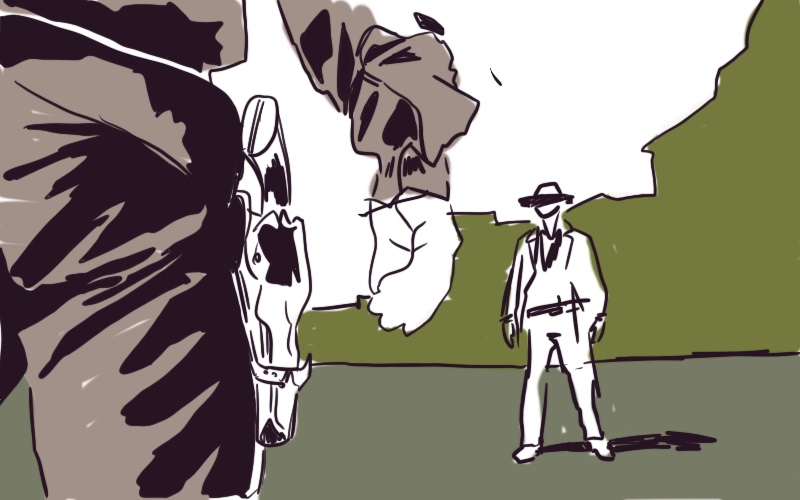I can’t ask my father if he has seen Anthony Mann’s Man of the West because my father is dead. A mild aficionado of the “western,” he might have come upon it, maybe on some meandering 70s’ or 80s’ Saturday afternoon in a pan-and-scan version on television. Or, maybe he watched a remastered copy on TCM in the last 20 years of his life, as cable television packages anchored him in those twilight years among the drumlins, kettles, and moraines in Northeast Wisconsin’s glaciated country. That atmosphere is a far ululation from the sunbaked dusty Hollywood Western often shot in Monument Valley, a specialty of John Ford, but not entirely counter to the greener landscapes of Anthony Mann’s westerns — the lush country of Oregon in Bend in the River, the more fertile terrain of California and Colorado in The Naked Spur, or the true glaciers of Alaska in The Far Country.
Man of the West was filmed all over Southern California, from the rolling green hills of Thousand Oaks to the broken rubble of Red Rock Canyon State Park. A major factor of Mann’s mise-en-scene is the filming locations (rarely sets), this then extends branchlike into actors, spacing, framing, and motion, which tinctures the film stock with a greater sheen of verisimilitude than most productions of the time. The studio cutaways of conversations can mar other older productions, but Mann doesn’t often do this and virtually not at all in Man of the West. Mann’s American pictorial style is reminiscent of a certain local painterly fashion, though almost with a roughshod quality born of poor barroom paintings, yet more Winslow Homer than Sargent in terms of color. Mann stencils in the brutality and violence that is his world — he knew where to put the camera and how to frame the high and low discrepancies that made up the wonderfully awful period of Manifest Destiny in his incredible series of Westerns, freely oscillating from vista to a ground-level close-up of sudden carnage. On the other side of the ocean, Dreyer and Antonioni knew the best arrangements for their overweening and listless characters, often in pictographs of despair borne out of Velasquez, Caravaggio, and De Chirico. I may be inviting a tripwire to break Western compositional patterns into two groupings, but there is a full stockade of information backing how geographically different people see the world differently — it’s held true over some time, in Europe one thinks about violence; in America, we act out violently and may or may not consider it later. As Lionel Trilling contended, “We are people of ideology,” and our ruptures are always freely showing. The old west never leaves us and people are armed to take out anyone who gets in our way, no matter if someone’s only chosen to eat at the restaurant the crazed decides to randomly shoot up. Even if our most cherished celebrities finally become victims, politicians will continue to legislate on the whole for guns because we have always been a savage nation, with many lacking any negative capability — the mantra, “We all have it coming,” from Unforgiven, always wins out.
In Mann, people get blown away in a very charged and unsentimental manner: the arrow to the just-introduced main female character in Bend of the River and the old prospector (the only likable male character) getting shot in The Naked Spur — it was as if Mann brought to the Western the cutthroat spirit of film noir, a genre he excelled in during the late 40s with T-Men and Raw Deal, among others. But in Man of the West, the violence and psychosexual threats get taken to another level. Mann’s cinematic impressions of these redoubtable subjects are as close as the art can get to the particular strain of mindless violence in the American spirit, as in Melville, Flannery O’Connor, and Cormac McCarthy, also succeed, by isolating and making a monument to cruelty and bloodletting in their writing.
Man of the West has a simple tense story that gets complicated by the set pieces in the second half-hour, the first coming after Link (the eponymous man, Gary Cooper) and the other two passengers, a singer and a conman is left by their train after a failed robbery by bandits. They walk the tracks, eventually coming upon the hideout of the infamous Doc Tobin and his gang (those same bandits). Doc is Link’s spiritual foster father, who once taught him thieving and killing. Years before, Link rebuked Doc, but now, in a wild reunion, he must play along and pretend to rejoin the fold who plan to rob a bank in Lasso, though, in reality, Link has finally been accepted into a community back home and has a wife and two children. Just after this fake reunion, the voluptuous singer, Billie, is forced to strip while one of Tobin’s minions, Coaley (Link’s hateful cousin), holds a knife to Link’s throat until Link deflects from the threat with talk of the upcoming heist. Then, on the way to Lasso, with everyone in a caravan, Link revengefully gets into a fight with Coaley — after continually goading, Link ruthlessly pulls off Coaley’s clothes, layer after layer, down to his drawers, leaving the man exhaustively crying like he has been ravished after orgasm, while Doc and the others watch, the former salivatingly saying, “I’ve never seen something like that in my whole life. Link, that was something to make an old man’s blood boil.” The humiliation of Coaley by stripping him is, of course, exactly what Coaley wanted to see from Billie, and this scene is probably what the Catholic Legion of Decency objected to when the film was first released, saying “The highly moral nature of this story is substantially marred by excessive brutality and unnecessary suggestiveness.” Not even in Kubrick had I witnessed moments of the film that are so naked in their singularity — here Mann went beyond his almost pedestrian representations (only making them more uncanny) of dealing with savagery to metaphorically “show” a man raping another man without penetration.
Man of the West has a well-heeled script, with echoes of King Lear (a Mann fascination — he wanted to bring it to the screen with three sons, like Kurosawa’s Ran) and, as per Robin Wood, one can go through everything with a symbolic finger as congruences appear like pots of gold: “Link is traveling from the new settlement of Good Hope to the established town of Fort Worth…he stops briefly at the small intermediate town of Crosscut,” but what overrides this, taking the film out of “filmed theater” or episodic television mode, is its cinematographic form, those electric images. Its cinematography — its soul — anticipated me, again and again, like hardly any film of the time, which must have been why Godard (who saw it in its time) wrote, “Each shot in Man of the West gives the impression that Anthony Mann is reinventing the western just as, let us say, Matisse’s pencil reinvents the line of Piero Della Francesca,” describing it as offering “the beauty of landscapes simultaneously with the explication of that beauty . . . art simultaneously with the theory of art . . . we have in each shot the analysis simultaneously with the synthesis.” The notion of the “West” gets expanded with the jarring tilts, tracks, and cuts on movement into movement like Mann had opened the door for me to step inside a time-warp. And the film is especially sensation-filled during the climactic sequence in the ghost town of Lasso, 15 minutes in duration, where another startling killing inaugurates a gunfight, leading to a two-on-one where Link is wounded, but eventually succeeds, killing three men. Mann presents us with this environment through several perspectives — these are not simply pictures of a landscape, they are a time and space come to life, as here where Link and another bandit ride to Lasso:
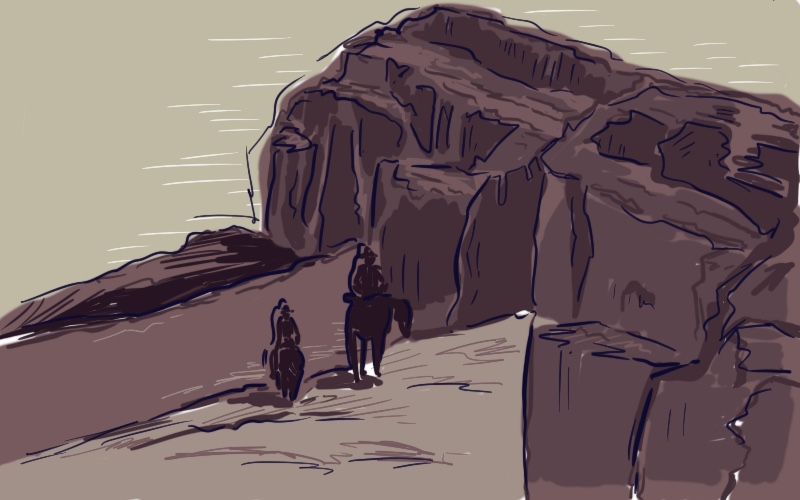
Even The Searchers, for all its grandeur, or, even Welles in the most crafted of his films, Chimes at Midnight, cannot let me into space the way Mann in Man does. I enter the space of Lasso and, while watching the silent maneuverings, I would not be slightly surprised if I saw myself on the fringe of a frame, with the same eerie simultaneity David Lynch uses when Diane (Laura Dern) distantly sees herself at the motel in the last episode of Twin Peaks: The Return. Because of Mann’s presentation, I imagine I’m belly-breathing that territory’s dry dusty air, just as if walking in the neighborhood I live in. The eerie sensation of falling into art and living in it — seen most figuratively in Kurosawa’s Dreams, where a tourist enters paintings of Van Gogh’s — is one of the metaphysical delights of art. Since the sense of cinema is so visual, there may be more of a dream-like quality to the imagining of it, whereas, in books, there is the sound of the words, the syntax, the tone both on and off the page — the stratification of these assortments complexifies our memories of them. Yet in the syntax of Yeats (“Now that my ladder’s gone / I must lie down where all the ladders start / In the foul rag and bone shop of the heart”) or in the rigors of Mann’s editing, there is a similar charge and a call to artistic arms, in style, something piquantly defined by Virginia Woolf:
Style is a very simple matter, it is all rhythm. Once you get that, you can’t use the wrong words . . . This is very profound, what rhythm is, and goes far deeper than words. A sight, an emotion, creates this wave in the mind, long before it makes words to fit it, and in writing one has to recapture this, and set this working, (which has nothing apparently to do with words) and then, as it breaks and tumbles in the mind, it makes words to fit in.
Style arrests and gives heft to our growing seasons. Something from Shakespeare, stuck in a fault-line for some decades since our sophomore year of college, folds over and opens like a peacock to us after so many seasons of experience salting our resume: “O, reason not the need! Our basest beggars/Are in the poorest thing superfluous./Allow, not nature more than nature needs,/Man’s life’s as cheap as beast’s.” At 19, do we really know, unless we are, what it is to be homeless, to be wanting for food? Even if we gave the lonely man on the quadrangle’s corner a dollar every few days, sophomore year is not the season of seeing — the more weighted realizations later will fricassee or smolder the taste of those relatively carefree hours.
Still, in film, I can much more literally fit myself in the object, as I can abide in the confines of the Overlook Hotel in The Shining, the Lake Tahoe Corleone compound in The Godfather II, or the manor house in Celine and Julie Go Boating, just as I walk that ghost town of Lasso whenever I want, with full consciousness. So indelibly have the directors of those films captured these spaces, and so much so in the former’s case, that I can recall at least a half-a-dozen alternate dream-made versions of The Shining— with running times near two hours — unsentimental pictures much more raw and frightening than the original, though Kubrick was the fuse driving the green flower. The scene in Lasso is the culmination of a dozen or so shots throughout that give the atmosphere a counterpoise — the sense of the other, another force that alternatingly analyzes and synthesizes, as Godard wrote. One-shot, especially, begins about 18 minutes in, after the three principals are abandoned by the train — they walk the tracks before coming to a place (the hideout) prefiguring their demise, as Link will regain his taste for violence and mayhem that will culminate in killing the Cronos figure that is Doc Tobin. Lush hills surround Doc’s hideout in the vale. The three stand at the crest of a hill for some seconds, while Link recognizes the structure — they begin to descend, but stop to be careful (the background hill a line through their heads), then they walk further down the hill, the camera following.
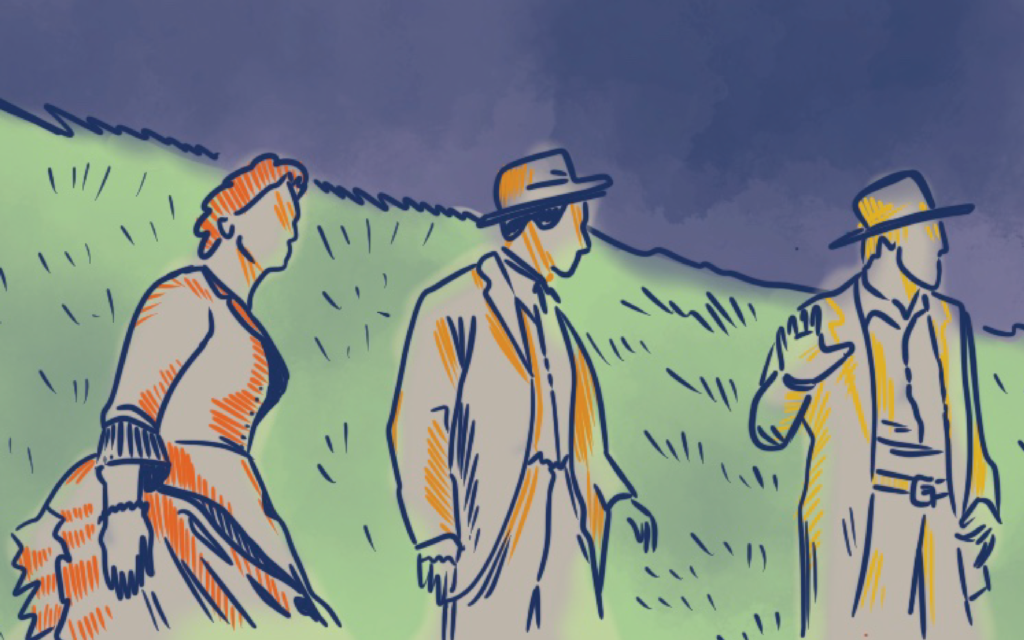
The shot is only 22 seconds in duration, but in the span of a work of art, it is enough to pop out in relief on its cinematic map.
Violence, because it is violence, is instant, yet in Mann, it is often hair-trigger, but nonetheless sacred — attitude felt in Cormac McCarthy’s books. McCarthy’s prose has a strange pattern to it, beginning in almost total abeyance to William Faulkner’s (they even shared the same editor, Albert Erskine), before more and more Hemingwayesque creeps into Blood Meridian and the two forces work in tandem until the curious drain of literary devices for his last two books, which many people remark are closer to screenplays — and indeed No Country for Old Men was originally one before its novelization. The weakness of The Border Trilogy compared to Blood Meridian is its sentimentality, especially in Cities of the Plain. The experience of Man of the West is more akin to Blood Meridian, and even the early Appalachian books, of which the first three are very cinematic: all atmosphere and action, with characters, who, according to Denis Donoghue, “are like recently arrived primates, each possessing a spinal column but little or no capacity of mind or consciousness” — akin to many of the tertiary characters in Mann’s westerns and a few main ones.
The link between Mann and McCarthy becomes less tenuous by keeping in mind Gilles Deleuze’s two cinema books Time-Image and Movement-Image and his bringing together one writer and one cinematic figure. Deleuze ventured that Dostoevsky and Kurosawa (Shakespeare being their ghostly father figure) were close because Kurosawa shared a concern with the Russian. They had a common problem — their characters were both engaged in impossible situations, with Deleuze further adding, “At the same time they are taken by this imagery, questions of life and death, they still know that there is another question that is more urgent, even if they are not exactly sure what it is.” The two sets may be similar duos, but on the surface only. Mann and McCarthy’s characters are American and not given to the same degree of the examined life as those of Dostoevsky and Kurosawa. The question of violence in Dostoevsky and Kurosawa is much different than in Mann and McCarthy, again with geography playing its part and though the latter men’s characters are engaged in impossible situations, they have no idea that there is another more urgent question. I have no idea if McCarthy has seen Man of the West, but he has certainly viewed his share of Hollywood westerns and has talked about Sam Peckinpah in an interview. When I first watched the Lasso sequence, I began to develop a fleeting feeling, easily discounted — but upon re-viewing, I came to understand that I was seeing Blood Meridian, what Blood Meridian could be like if ever filmed, but probably won’t be or else will be highly disappointing, like every other film version of a McCarthy novel. Specifically, the Lasso sequence took me back into the spare pages after the book’s climactic Indian massacre when the only ones left are the judge, the kid, the fool, and Tobin, the ex-priest. The short declarative sentences that my imagination brought out of my backwaters, windmilling them up to the sky, were these:
He could see through the lattice of bones the judge and his charge on the hill in the sun and he raised the pistol and rested it in the saddle of a rancid pelvis and fired. He saw the sand jump on the slope behind the judge and the judge leveled the rifle and fired and the fireball whacked through the bones and the shots rolled away over the dunelands,
which now had complimentary images:
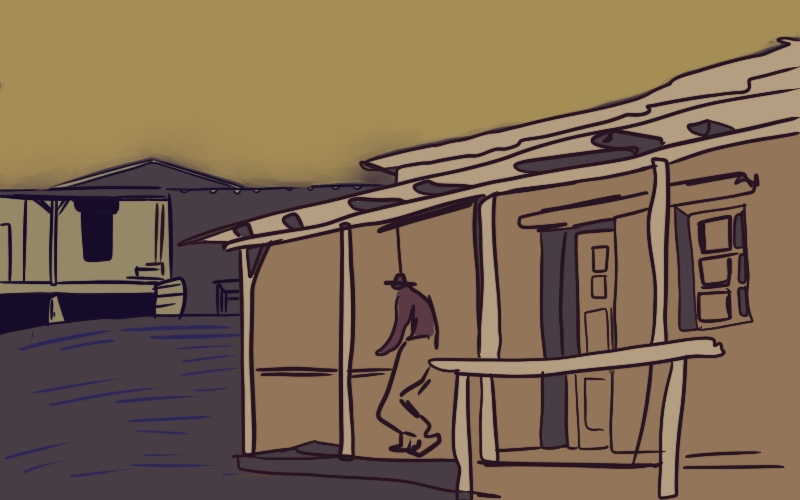
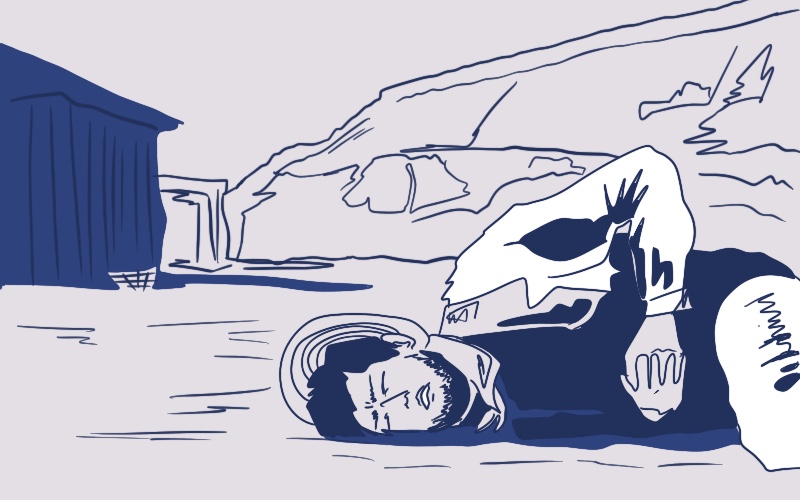
And as the time-image (Cinema, Deleuze says, is blocks of movement-time that tell stories) runs into the literary image, rear-guardedly, it produces a strange synthesis — the receiver of art always creates a much richer experience because it burns into their memories, their life, as raw material — the chainsaw and the tree, though sometimes it is hard to tell which is which.
The experience of cinema and literature can put some people into the same passionate heat. The durations might be different, but that psychic muscle exercised by great art gets taken for a similar marathon (Guy Davenport: “A work of art, like a foreign language, is closed to us until we learn how to read it”), wherein the best first response might be what a friend spoke after we watched The Bitter Tears of Petra Von Kant: “I don’t know what to think of that.” Because “to think” on some things, while at times juicy, can often lead to litigating for or against. T.S. Eliot: “Poetry communicates before it can be understood . . . ” and, maybe, in some cases, some art is better-left un-understood. To foist meaning onto art saps and impurifies its force, with a good example being a recently unearthed phone call with Stanley Kubrick “explaining” the endings of 2001 and The Shining, taking the energy out of his images and sounds which artistically created what he described but did so unconsciously and not tendentiously — the viewer by themselves found (even created) their own meaning.
The experiences of Man of the West in 2020 and reading Blood Meridian 20 years prior were bridged by something much more submerged than violence — there is some speckled myth behind the works that looms larger than the Manifest Destiny — they are much more grounded in the Ancients: Homer, Euripides, Sophocles. To “feel” violence, of which the tragic has to be a component, is something much more unsettling and witchy than the program of Tarantino carnage and its ilk, who think theirs impressive just because it’s cool, though it is borne of the Kung Fu irreality of Bruce Lee. Robin Wood wrote that it was a short step from Mann to The Texas Chainsaw Massacre, but I will go further, and say the short way from there to Tarantino is one that cannot be made. Tarantino’s violence seems so much beside the point it is without a point, mainly because the context is a pastiche kitsch land with shallow characters. To “feel” violence is to be implicated in it—when it is gaudy and comic-book and kung-fu, it’s meaningless. If Tarantino read Shakespeare, Dostoevsky, and McCarthy (no doubt he saw Kurosawa and Mann), he didn’t understand the expressiveness of violence, how it curates its own brood. The anal rape sequence in Pulp Fiction pales next to Link tearing the clothes off Coaley. The latter is coiled sexuality, and both organic and subversive, while still being only 1958 — it does more than show, it bends the weather inside one, the vane twisting and twisting and not quite finding congress but buttressing between breaking into blossom and moral turpitude. It’s a scene Quentin Tarantino only wishes he knew how to finesse, or indeed, fathom.
The “western,” and “film noir” are our country’s greatest two contributions to the art of narrative cinema — the “noir” signifying that the French, who created cinema, dubbed the genre with a better-sounding poetic term and better for us because french’s “noir” trounces the starkness and endless connotations of “black.” I have never adhered to the “western,” as I don’t choose my art by genre, but I know why my father loved them — he wanted to be inside them, somehow, or, at least, in their country. The Ford/Wayne westerns had touched off an ache in him — that urge for going, though he never did — and when I told him I was moving to Oregon, just a week after motoring through the uncanny Columbia River Gorge before coming near Mount Hood, where Bend in the River was filmed, he immediately said, I’ll live vicariously through you. We watched Unforgiven together—I’d watched Three Godfathers from a distance and reported on it to him. I also once read him the beginning of Blood Meridian, where the judge falsely accuses a preacher and incites an audience to attack him; my father’s immediate response was: “I never would have been taken in by him.”
Something struck me during the age-range of the great discoveries, one’s twenties when I thought cinema was to be my honey. In a New York Times Sunday Magazine profile, I read about indie director Hal Hartley. When asked about his hard-hearted father, he was reported to have said, “Actually, I have been moving toward my father my whole life.” I must have held a frisky feeling how, one day, this measure might mean even more to me than the seemingly blinking X-mas lights surrounding it then. It didn’t take my father’s death, a scene more out of Dostoevsky than Mann or Kurosawa, but the time following, a year or six or seven seasons, to arrive there. Many years ago, I thought it cool, yet so calculated, to shuck off one’s parents like the dressings over wounds they are destined to have caused. But we often misinterpret the wounds around our creators — our pop culture directs enough disfigurement of our memories to last a lifetime. And then there is the slow-drip of timeless art, those halls of Shakespeare, the sound and fury of Emerson’s essays, Ingmar Bergman’s bleak but burning meditations, and how they break or bend against existence. “Actually I have been moving toward my father my whole life.” It’s there inside one and when it gets loosened, it’s a paradoxically quiet avalanche — the kind of Hollywood ending that is impossible to finance. “Coming full circle” is the weakest cliche to describe it. What I began to experience in my lonely meditations on Man of the West was not the sensation of moving toward him (though he is dead), but the thought that I already had, and had come into his country, descrying Wordsworth’s “The child is the father of the man” (repurposed by McCarthy in the first paragraph of Blood Meridian) as both destiny and tragedy, the twin rivers of wisdom. It had happened without feeling any cog clicks into settings, it simply already was—a telling example of how one’s consciousness is perpetually playing catch-up to those deep strong emotions turning our clocks. •
